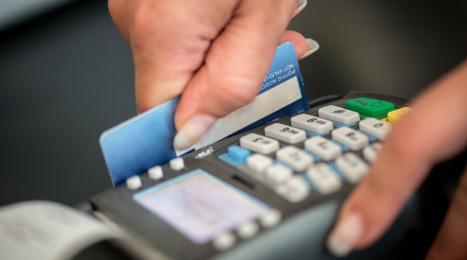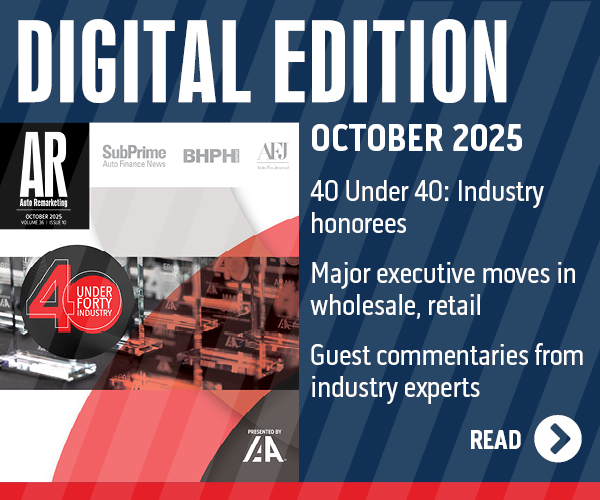In a move similar to the one made by the captive for Toyota and Lexus, Hyundai Capital America, which does business as Hyundai Motor Finance, Genesis Finance and Kia Motors Finance, has announced that it is offering payment relief solutions to its customers affected by Hurricane Harvey.
“We are concerned about the well-being and immediate safety of our customers that have been displaced by this unprecedented storm,” Hyundai Capital America president and chief executive officer Ross Williams said.
“Our thoughts and prayers go out to everyone in Texas and all across the Gulf coast,” Williams went on to say
Hyundai Capital America indicated impacted lease and finance customers residing in the impacted areas may be eligible to take advantage of several payment relief options, some of which include:
—Payment extensions
—Redirecting billing statements
—Arranging phone or on-line payments free of charge
Customers who would like to discuss their account options are encouraged to contact Hyundai Motor Finance, Genesis Finance and Kia Motors Finance for further assistance.
As experts and policymakers shared a variety of economic trend updates and observations, Fitch Ratings summarized that record-setting payment performance isn’t likely to simply last forever.
But at the same time, Fitch reiterated that deterioration of auto finance performance — especially in the subprime space — won’t pull the entire economy into a tailspin like some pontificators keep trying to allege.
In analysis released this week, Fitch acknowledged the continued financial resilience of the U.S. consumer has prolonged a period of “extremely strong” asset quality among many U.S. consumer lending segments. However, analysts insisted that U.S. consumer loan losses at financial institutions are at “unsustainable” cyclical lows and a more meaningful amount of credit deterioration should be expected over the near to medium term.
“This will particularly be the case should unemployment claims begin to reverse after reaching multi-decade lows,” Fitch said.
A month after the rate tied a 10-year low, S&P Dow Jones Indices and Experian released data through June on Tuesday and determined auto loan defaults decreased 3 basis points from the previous month to settle at a new low mark of 0.82 percent. The May reading had tied for the lowest mark analysts have seen during the past 10 years. In June 2015, the auto finance default rate also stood at 0.85 percent.
The new low record might not last, as the rate has made an upward movement from June into July during five of the past eight years. The most pronounced rise in the cyclical pattern arrived in the immediate aftermath of the Great Recession, when the rate in June 2009 of 2.18 percent jumped to 2.46 percent a month later.
Fitch explained the extent to which weaker credit performance will be a challenge for individual consumer lenders and finance companies will vary depending on the diversity of their activities and the extent to which they have strengthened capital and loss reserves to absorb higher losses. Analysts added their willingness to tighten underwriting standards in recent quarters in anticipation of a weaker macroeconomic environment will also be a key factor.
“Reflecting these dynamics, Fitch believes diversified banks are better positioned than mono-line lenders to weather meaningful erosion in consumer asset quality,” analysts said.
Fitch also pointed out that credit cards and auto loans — particularly retail credit cards and subprime vehicle installment contracts — will be the consumer loan segments most likely to see asset quality deterioration in the near to medium term. The firm noted higher loss rates and delinquencies have already begun to materialize.
“Drivers of weaker credit performance include stronger loan growth in recent years, increased competition leading to looser underwriting standards in the post-financial crisis period (including greater exposure to subprime borrowers) and, in the case of auto lending, residual values that have been supported by unsustainably high used vehicle prices,” analysts said.
According to Federal Reserve surveys, banks have begun tightening underwriting standards in both segments over the past several quarters.
“The potential systemic impacts of a rapid deterioration in either credit card or auto lending are limited relative to pre-crisis residential mortgage lending,” Fitch said. “Both segments are much smaller than residential mortgage debt with shorter loan durations and smaller loan balances.”
Ability to maintain payments
While Fitch referenced the impact unemployment might have on consumers’ ability to maintain their debt commitments, the latest analysis from Comerica Bank took a closer look at the latest federal employment report that indicated payroll employment increased by 222,000 net jobs in June.
Comerica Bank mentioned that revised figures for April and May triggered the unemployment rate to tick up slightly to 4.4 percent.
“This is not a sign of a cooling labor market. We expect that labor market conditions will continue to tighten through the second half of this year,” Comerica Bank chief economist Robert Dye said in the commentary.
Comerica also mentioned the average workweek inched up by one tenth of an hour to 34.5, and average hourly earnings increased moderately by 4 cents, or 0.2 percent.
“So this labor report hit the trifecta, showing that more workers worked longer hours and got paid more for it,” Dye said. “This is supportive of income growth in June and beyond and consumer spending, too.”
Comerica Bank maintained that despite this labor market data, the Federal Reserve is likely to leave interest rates where they currently are at 1.25 percent when the Federal Open Market Committee meets beginning on Tuesday. Dye is also projecting that the Fed will announce the beginning of balance sheet reduction at its September meeting and that another 0.25 interest rate rise should come in December.
During her semiannual appearance before the House Financial Services Committee, Federal Reserve chair Janet Yellen reiterated the strategy policymakers plan to leverage.
“The committee continues to expect that the evolution of the economy will warrant gradual increases in the federal funds rate over time to achieve and maintain maximum employment and stable prices,” Yellen said in her prepared testimony. “That expectation is based on our view that the federal funds rate remains somewhat below its neutral level — that is, the level of the federal funds rate that is neither expansionary nor contractionary and keeps the economy operating on an even keel.
“Because the neutral rate is currently quite low by historical standards, the federal funds rate would not have to rise all that much further to get to a neutral policy stance,” she continued. “But because we also anticipate that the factors that are currently holding down the neutral rate will diminish somewhat over time, additional gradual rate hikes are likely to be appropriate over the next few years to sustain the economic expansion and return inflation to our 2 percent goal.
“Even so, the committee continues to anticipate that the longer-run neutral level of the federal funds rate is likely to remain below levels that prevailed in previous decades,” Yellen went on to say.
And with regard to rate hikes the Fed already made, TransUnion’s analysis showed that most borrowers were able to absorb their increased monthly payment obligations after the Fed’s rate hike last December.
TransUnion’s study identified these 63 million consumers because they carried debts for which the minimum monthly payment due was tied to the market interest rate, such that a rise in rates from the December rate hike could cause an increase in payments required. TransUnion used its CreditVision aggregate excess payment (AEP) algorithm, which incorporates monthly payments from mortgages, credit cards and other debt obligations, to identify 10.6 million of these consumers who were at elevated risk of not having the capacity to absorb a rate increase of 0.25 percent.
The study then tracked the performance of these consumers through the end of March to give the December rate increase enough time to affect payment obligations. The study found that, in fact, only 1 million of these consumers were delinquent at the end of March. This was slightly lower than the study’s control group, who had no variable-rate products.
TransUnion explained this result implies that consumers with variable-rate credit were able to manage the rate increase as well as, or better than, consumers without variable-rate products.
“When we announced our ‘capacity to absorb a rate increase’ metric last May we said that it was a conservative measure of risk, in that it did not account for contributions to savings or investments that could be reallocated to cover debt service increases,” said Ezra Becker, senior vice president of research and consulting at TransUnion.
“We described our metric as an upper bound on the number of consumers who would struggle with a rate increase,” Becker continued. “We’re pleased to see that only 10 percent of those consumers we had considered at elevated risk of payment shock from a rate increase exhibited delinquency over the study period. Most consumers appeared able to reallocate their available cash, or make small changes to their spending habits, to effectively absorb the December rate increase.”
More about the overall economy
Fitch is maintaining its view that U.S. GDP growth will rise in 2017 and 2018.
“Increases in interest rates unaccompanied by meaningful economic growth and expanding wages could pressure consumer asset quality as it would result in increased debt service (for floating-rate obligations) and elevated refinancing risk without the benefit of higher income to absorb these costs,” analysts said.
“We believe that recent Fed rate hikes are part of long-term monetary policy normalization that is aligned with current macroeconomic conditions and the outlook,” they continued.
In the first quarter, Fitch mentioned U.S. consumer debt returned to its pre-crisis peak of $12.7 trillion after falling to a post-crisis low of $11.2 trillion in 2Q13. The student loan and auto segments have had the most pronounced increases, although credit card debt has also accelerated recently.
Between Q4 2008 and Q1 2017, Fitch calculated that student loan debt more than doubled to $1.3 trillion while auto finance balances increased by 48 percent to $1.2 trillion.
Over the same period, Fitch added that the much larger mortgage component of consumer debt declined by 6.8 percent to $8.6 trillion from a peak of $9.3 trillion, reflecting substantially tighter underwriting amid increased regulation and the exit of many non-bank lenders.
“Looking ahead, my colleagues on the FOMC and I expect that, with further gradual adjustments in the stance of monetary policy, the economy will continue to expand at a moderate pace over the next couple of years, with the job market strengthening somewhat further and inflation rising to 2 percent,” Yellen told House lawmakers.
“This judgment reflects our view that monetary policy remains accommodative,” she continued. “Ongoing job gains should continue to support the growth of incomes and, therefore, consumer spending; global economic growth should support further gains in U.S. exports; and favorable financial conditions, coupled with the prospect of continued gains in domestic and foreign spending and the ongoing recovery in drilling activity, should continue to support business investment.
“These developments should increase resource utilization somewhat further, thereby fostering a stronger pace of wage and price increases,” Yellen added.
How contract holders in your auto finance portfolio make future payments continues to be an evolving topic, as a recent survey conducted by Viewpost showed.
Viewpost, a network for invoicing, payments and cash management, produced a survey of American consumers covering the future of payments and key issues around awareness of payment technologies, as well as perceptions about what will be the most popular and useful tools for paying and getting paid in the future.
The company surveyed a cross-section of 1,000 U.S.-based consumers, finding that overall, 80 percent of Americans are in support of “futuristic” payments technologies and currencies, including tools like sensor fingerprinting, facial recognition, retinal scanning and voice control, as well as currencies like bitcoin.
The company acknowledged electronic payments have become commonplace today, with nearly 51 percent of people reporting that they are paid electronically via direct deposit, and an increasing comfort level with these paperless transactions appears significant in driving consumers’ interest in even more sophisticated forms of electronic payment.
Respondents are unenthusiastic about traditional paper checks, as one-third of them think that paper checks will die within five years, and 83 percent believe they will be completely eliminated within the next 20 years.
Similarly, only 11 percent of Americans think that companies will bill their customers via paper in the future, while over half of Americans (54 percent) believe that companies will bill their customers via automatic payments from their bank account or credit card.
A mobile and app-based future is definitely on consumers’ minds, with 52 percent saying they believe that payments between companies and customers will be exchanged via mobile app.
Futuristic currencies and payment technologies — particularly biometrics — are highly anticipated, and Viewpost’s survey data bears this out. Notable findings include:
• Sensor fingerprinting: 50 percent of Americans believe fingerprint technology will be used for authentication to pay and receive payments over the next 10 years.
• Facial recognition: 35 percent see facial recognition as a key authentication technology for making payments within the next 10 years, and 32 percent of Americans trust facial recognition for securing electronic payments.
• Retinal scanning and voice control — these advanced biometric methods have gained traction in consumers’ consciousness, with some 31 percent citing retinal scanning as a viable technology for authenticating payments and 18 percent seeing themselves using voice control to make payments by 2027.
Viewpost insisted that consumers are clearly not afraid of new technologies that can make electronic transactions more secure, frictionless and, therefore, simpler. Even previously maligned technologies like bitcoin are seeing acceptance, as some 21 percent of consumers see it as a viable currency within the next 10 years.
“People are willing to embrace a more convenient, frictionless payments future,” Viewpost chief executive officer Max Eliscu said. “Paper invoicing and checks are well on their way out in the consumer setting, and more businesses across the spectrum are beginning to follow suit with transactions among their trading partners.
“But electronic invoicing and payments are just the beginning — the future of the payments industry is highly dependent on leveraging innovation like biometrics, data integration, and a growing variety of payment methods to securely drive more volume with visibility, speed and simplicity,” Eliscu went on to say.
As buyers’ appetites for bigger and more expensive vehicles grow, Edmunds found the contract term length for new-model financing reached an all-time high in June with the terms for used-vehicle deliveries not far off that record-setting pace.
According to a new analysis released on Monday, Edmunds determined the average contract length for new-vehicle financing stretched to 69.3 months in June — up 6.8 percent from five years ago.
On the used-vehicle side, analysts indicated term length grew by 6.0 percent during the past five years to land at 66.9 months in June.
While the term lengths might be similar, the other metrics Edmunds shared in the used-vehicle market versus the new-model realm showed the variance in financial capacity and willingness to take on debt.
Edmunds found the average amount new-car buyers financed in June recorded the biggest uptick for the year, hitting $30,945; that’s a spike of $631 from May. With a larger outstanding balance, Edmunds pointed out these buyers are now carrying the highest monthly payments for the year, averaging $517 in June, which is up from $510 in May.
As far as used vehicles, Edmunds’ analysis showed the average amount financed sat at $21,142, leaving contract holders with a monthly payment at $383.
“Stretching out loan terms to secure a monthly payment they’re comfortable with is becoming buyers’ go-to way to get the cars they want, equipped the way they want them,” said Edmunds executive director of industry analysis Jessica Caldwell.
“It’s financially risky, leaving borrowers exposed to being upside down on their vehicles for a large chunk of their loans, but it’s also a sign that consumers are still confident enough in the economy to spend more on their vehicles and commit to paying for them longer,” Caldwell continued.
Finance companies are attempting to mitigate their risk by securing larger down payments for both new- and used-vehicle deliveries.
In June, down payments jumped by healthy amounts on a year-over-year basis, rising 7.1 percent to $2,453 for used-vehicle deals and climbing 6.6 percent to $3,687 for new-model deliveries.
Also of note, Edmunds also noticed that the APR on new-vehicle financing dipped just below 5 percent for the first time since February, averaging 4.96 percent in June. The APR has increased 5.7 percent from a year ago and 13.6 percent from five years ago.
For used-car financing, the average APR came in at 7.64 percent, which is 2.7 percent higher year-over-year, according to Edmunds, which also pointed out that the June average rate was actually 5.4 percent lower than five years ago.
Meanwhile, the analysts over at Kelley Blue Book also added to the discussion, sharing on Monday that their estimated average transaction price (ATP) for light vehicles in the United States came in at $34,442 in June.
KBB reported new-car prices have increased by $511 or 1.5 percent year-over-year, while remaining relatively flat compared to May.
“Transaction prices grew more slowly than normal in June, increasing less than 2 percent,” said Tim Fleming, analyst for Kelley Blue Book. “As the industry enters a ‘post-peak’ environment for new-car sales, more pressure will be placed on transaction prices.
“Kelley Blue Book is seeing more mixed results among manufacturers and popular segments, such as full-size trucks and mid-size cars, both of which are flat, as well as compact SUVs, which rose 1 percent. These trends are likely to continue as retail sales weaken,” Fleming went on to say.
This week, Pelican Auto Finance selected Payix to provide its collections tools, including its new mobile collections application. The tools are designed to help Pelican better connect with its contract holders and improve its ability to collect installment payments.
The companies highlighted the mobile app and other tools are white labeled and integrate with Pelican’s portfolio management system in real time. They allow borrowers to make payments quickly, easily and securely — and without paying convenience fees often charged by other payment processors.
The app is now available to Pelican borrowers under the finance company’s name in Google Play and the App Store.
“The Payix mobile app is for reaching more than millennials. It’s exactly what the subprime automotive finance market needs to reach all of its borrowers,” said Joel Kennedy, chief operating officer of Pelican Auto Finance. “It allows us to seamlessly integrate consumer payments and communications into our system, and it makes it incredibly easy for our customers to engage with us, too.
“I really think any lender without an app like this runs the risk of falling behind,” Kennedy added.
In addition to providing collections tools, Payix also offers payment processing resources and business intelligence solutions typically available only to large-scale finance companies. Now providers of any size have access to a broad range of resources that are effective, affordable and easy-to-use, according to Payix president Chris Chestnut.
“We’re excited to have been selected by the great team at Pelican Auto Finance to provide our collections tools and payment processing resources,” Chestnut said.
“As a new company, we really appreciate being able to work with a lender as experienced and knowledgeable as Pelican,” he continued. “Their help and support have been invaluable to us, and we’re 100 percent committed to providing them with solutions that help their business and borrowers succeed.”
Experian Automotive tried again this week to pop the talk about a “subprime auto loan bubble.”
Analysts said, “There’s always someone who claims that the bubble is bursting. But a level-headed look at the data shows otherwise.”
According to Experian’s State of the Automotive Finance Market report, 30-day delinquencies dropped and subprime auto financing reached a 10-year record low for the first quarter. Analysts indicated the 30-day delinquency rate dropped from 2.1 percent in Q1 2016 to 1.96 percent in Q1 2017, while the total share of subprime and deep-subprime installment contracts dropped from 26.48 percent in Q1 2016 to 24.1 percent in Q1 2017.
“The truth is, lenders are making rational decisions based on shifts in the market. When delinquencies started to go up, the lending industry shifted to more creditworthy customers. This is borne out in the rise in customers’ average credit scores for both new and used vehicle loans,” analysts said.
Experian noted that the average customer credit score for a new-vehicle contract rose from 712 in Q1 2016 to 717 in Q1 2017.
The company added the average customer credit score for a used-vehicle loan rose from 645 in Q1 2016 to 652 in Q1 2017.
In what Experian called “a clear indication” that finance companies have shifted focus to more creditworthy customers, super prime was the only risk tier to grow for new-vehicle financing from Q1 2016 to Q1 2017. Super-prime share moved from 27.4 percent in Q1 2016 to 29.12 percent in Q1 2017.
All other risk tiers lost share in the new-vehicle financing category:
• Prime: 43.36 percent in Q1 2016 to 43.04 percent in Q1 2017.
• Nonprime: 17.83 percent in Q1 2016 to 16.96 percent in Q1 2017.
• Subprime: 10.64 percent in Q1 2016 to 10.1 percent in Q1 2017.
For used-vehicle financing, Experian spotted a similar upward shift in creditworthiness.
Prime and super-prime risk tiers combined for 47.4 percent market share in Q1 2017, up from 43.99 percent in Q1 2017.
At the low end of the credit spectrum, subprime and deep-subprime shares fell from 34.31 percent in Q1 2016 to 31.27 percent in Q1 2017.
“The upward shift in used vehicle loan creditworthiness is likely caused by an ample supply of late model used vehicles,” Experian analysts said. “Leasing has been on the rise for the past several years (and is at 31.06 percent of all new vehicle financing today).
“Many of these leased vehicles have come back to the market as low-mileage used vehicles, perfect for CPO programs,” they went on to say.
Experian also mentioned another key indicator of the lease-to-certified pre-owned impact is the rise in used-vehicle financing share for captives. In Q1 2017, captives had 8.3 percent used-vehicle share, compared with 7.2 percent in Q1 2016.
In other findings:
• Captives continued to dominate new-vehicle financing share, moving from 49.4 percent in Q1 2016 to 53.9 percent in Q1 2017.
• 60-day delinquencies showed a slight rise, going from 0.61 percent in Q1 2016 to 0.67 percent in Q1 2017.
• The average new vehicle contract reached a record high of $30,534.
• The average monthly payment for a new vehicle installment contract reached a record high of $509.
TransUnion discovered that maintaining payments on that vehicle installment contract no longer is the top priority when the holder hits a rough financial patch and has to adjust to being short on monthly income.
When faced with the choice of which debts to pay and which to miss, the latest TransUnion study found that consumers in financial distress tend to prioritize unsecured personal loans ahead of other credit products such as auto financing, mortgages and credit cards. These findings were released during TransUnion’s annual Financial Services Summit, attended by more than 300 senior-level financial services executives from around the globe.
The study incorporates unsecured personal loans for the first time since TransUnion began analyzing the payment hierarchy dynamic in 2010. Beyond personal loans, this most recent analysis is consistent with prior TransUnion studies in finding that consumers have historically prioritized auto finance payments over their mortgages and credit cards, and have done so consistently since at least the beginning of 2004.
“It is quite surprising to us that, for most struggling consumers, unsecured personal loan payments are prioritized over other prominent credit products such as mortgages and auto loans,” said Ezra Becker, senior vice president and head of research for TransUnion’s financial services business unit.
“While personal loans have existed for a long time, recent growth in the number of such loans led us explore this product’s position along the payment spectrum,” Becker continued. “The prioritization of personal loan payments above all others is counterintuitive, but our study results are clear.
“We believe the relatively short duration of these loans — usually less than 30 months — is a key factor in the decision process of consumers,” he went on to say.
Recent TransUnion data show that average term lengths are much shorter for unsecured personal loans. For loans originated in Q4 2016, unsecured personal loans had an average term of 28 months. In this same timeframe, the length of vehicle installment contracts averaged 60 months and mortgages averaged 230 months.
“We conjecture that personal loan borrowers may feel they can get a quick win with these loans even when they are struggling, and there is a clear, near-term end to the obligation — a ‘light at the end of the tunnel,’ in a sense,” said Becker.
“In contrast, auto loans and mortgages have much longer terms, and credit cards have no set end date,” he continued. “Finding an opportunity to pay a debt in full can be a powerful motivator for a struggling consumer.”
Historical payment patterns ‘shocked’ during great recession
Prior to including unsecured personal loans in the payment hierarchy analysis, TransUnion had reviewed payment patterns for auto financing, credit cards and mortgages. Since at least 2004, consumers with auto financing, credit card and mortgage have prioritized their vehicle payments.
Mortgages have traditionally been the second payment made, followed by credit cards.
“Auto loans have traditionally been the prioritized payment because most people need a car to get to and from work, run errands or bring their kids to school or other activities,” said Nidhi Verma, senior director of research and consulting in TransUnion’s financial services business unit.
“The far majority of the population does not live in markets such as downtown New York or Chicago, which have strong public transportation infrastructures. Viable alternatives to owning a car are scarce, hence the need to keep up with auto loan payments,” Verma continued.
Analysts determined this dynamic changed dramatically during the Great Recession as the housing crisis devalued millions of homes. As a result, the payment hierarchy flipped in Q3 2008, with consumers paying their credit cards prior to their mortgages.
“As housing values began crashing in 2007 and 2008, many homeowners found themselves ‘underwater’ on their mortgages, meaning they owed more on their mortgages than the value of their homes. With unemployment sharply rising, a lot of these borrowers began to emphasize their credit card payments, protecting their liquidity as a vehicle to pay their bills or simply to put food on the table,” Verma said.
TransUnion asserted this trend lasted well into the housing market recovery, reverting to the historical norm in Q1 2014.
“The payment hierarchy is complex — the decision process for struggling borrowers is a difficult one,” Becker said. “We confirmed through our study that both the strength of the labor market and housing values continue to be critical drivers of that decision process.
“In addition, the timing of consequences, availability of alternatives and social stigma all play a role,” he continued. “The housing crisis was a shock to the system that we fervently hope was a once-in-a-lifetime occasion.
“Barring another such trauma to the consumer credit market, we believe financially constrained borrowers will tend to pay their personal loans, auto loans, mortgages and credit cards in that order,” Becker concluded.
A quartet of auto finance technology firms collaborated this week on a pair of relationships aimed at enhancing both originations and payments.
First, Payix and Nortridge Software announced they formed a strategic alliance to help finance companies connect with their borrowers and improve their ability to collect payments. The alliance is geared to allow Payix to offer real-time integration between its suite of collections tools and the Nortridge Loan System (NLS).
Then, AutoGravity announced a partnership with CarFinance.com, a direct to consumer online finance company that is an affiliate of Flagship Credit Acceptance. The partnership is designed to give qualified users access to even more financing options through the AutoGravity digital platform.
Both developments come at time when the latest report generated by the Federal Reserve Bank of New York declared that 2016 officially represented the year of the highest auto finance originations — at least in the 18-year history of the data officials obtained from Equifax.
Payix’s collections tools include its intuitive, engaging and affordable mobile collections application, as well as web, interactive voice response (IVR), text and collector portal applications. Nortridge explained that its clients can add the Payix solutions to their existing collections tools with virtually no IT work on their part and in just a few weeks’ time.
“Lenders are always striving for ways to improve collections,” Nortridge Software president and chief executive officer Greg Hindson said. “The integration between Nortridge and Payix makes it easy for borrowers to pay anywhere and anytime — benefiting both borrowers and lenders.”
Executives went on to mention the Nortridge and Payix teams collaborated in the development of the seamless web services interface between the Nortridge Loan System and the Payix payment system, ensuring that transactions could be carried out in real-time and without interruption.
“We are elated to partner with an organization as strong and well-respected as Nortridge Software,” Payix president Chris Chestnut said. “Their products are incredibly flexible and reliable, and their team of industry leaders is fantastic to work with. We both realize our organizations are stronger together, and we couldn’t be more pleased to be able to form this alliance with them.”
Payix’s collections tools are white-labeled to help finance companies promote their own brands with their borrowers, and they were specifically designed for any size lender to use easily and affordably. Chestnut elaborated about the tool in this report from SubPrime Auto Finance News.
So finance companies can have more contracts on which to collect, the team at AutoGravity contends its smartphone technology helps potential buyers get up to four personalized finance offers on the new or used vehicle of their choice — on average in under 10 minutes.
Designed with state-of-the-art security, AutoGravity protects user information with advanced bank-level encryption to ensure that sensitive information is processed securely. The tech company also recently confirmed that its network of partner dealerships has grown to more than 1,400 franchised dealers.
“AutoGravity transforms car financing by empowering car buyers with up to four binding finance offers in minutes,” AutoGravity founder and chief executive officer Andy Hinrichs said. “Growth in our network of partner lenders creates more options for our users, marking another great step forward in delivering a world-class digital car shopping and financing experience.”
CarFinance.com joins a growing list of automotive finance providers that have embraced proprietary AutoGravity technology to allow consumers to shop for vehicles and see personalized financing options, all from the convenience of their mobile phones. Users are empowered by a one-of-a-kind financing experience that delivers efficiency, transparency and freedom of choice.
“We are pleased to partner with AutoGravity, a rising star in the digital car financing market,” said Samuel López, senior vice president and general manager of CarFinance.com. “More consumers are using digital tools to shop for and finance their cars, as we have seen with our customers at CarFinance.com.
“Our partnership with AutoGravity will provide car buyers, particularly millennials, access to our suite of best-in-class online tools that make it easy to complete the entire loan process online,” López continued.
Finance offers from CarFinance.com are now available to shoppers on all versions of the AutoGravity auto financing platform.
“Our success at CarFinance.com is driven by our ability to offer a fantastic user experience as our customers secure financing for their next car,” said Gerry Quinn, vice president of business development at CarFinance.com.
“Through our partnership with AutoGravity, we are seizing the opportunity to expand our reach and serve new customer segments with a cutting-edge mobile solution that complements our own digital lending platform and seamless online journey,” Quinn went on to say.
Financial advising firm UBS used the grim illustration of the “canary in the coalmine” at the beginning of a report it released this week involving the subprime auto finance space. To recap, that illustration stems from miners using caged canaries as a crude toxic gas detection method.
While birds didn’t appear to be harmed as UBS analysts compiled their report, they did acknowledge that a combination of factors has created an interest spike in subprime auto finance five times the normal level the firm typically receives from the investment community. The combination of deteriorating subprime auto finance metrics and results from its first-quarter consumer survey shedding light on the likelihood people will default sometime this year triggered the Wall Street fervor, according to the report obtained by SubPrime Auto Finance News.
“There are increasing signs that risky assets are vulnerable at elevated levels, from upticks in consumer delinquencies, to a major slowdown in bank and non-bank lending, to a stubborn increase in delinquent working capital loans,” UBS strategists Matthew Mish and Stephen Caprio wrote in the report.
The sentiment about defaulting came from UBS’ own research. Its Q1 survey revealed that 17 percent of participants said they either “strongly agree” or “agree” with the statement that "I am likely to default on a loan payment over the next year.” That question about payment not only includes auto financing but also other non-mortgage categories such as credit cards and student loans.
While the reading softened by 1 percentage point on a sequential basis, UBS pointed out the level soared about the survey mark generated in Q3, which was 12 percent.
And in terms of demographics, UBS’ survey showed that consumers between the ages of 21 and 34 told the firm they were most likely to default this year. Also of note, the annual income level of participants who acknowledged a default was coming this year was the highest segment among the three designated by UBS — individuals making $100,000 or more annually.
Mish and Caprio also referenced a previous report they compiled that mentioned many elements regarding delinquency and default previously highlighted by SubPrime Auto Finance News. The trends touched on S&P Global Ratings reporting that collateral performance in the U.S. subprime auto loan asset-backed securities (ABS) sector weakened in 2016 for the fourth straight year.
Also of note, the Federal Reserve Bank of New York indicated the amount of consumers who had a bankruptcy added to their credit reports during the fourth quarter softened to a new low going back 18 years.
The New York Fed reviewed Equifax data and found about 204,000 consumers had a bankruptcy notation added to their credit reports in the fourth quarter; an amount 4 percent below the same quarter in 2015 and a new series low that goes back to 1999.
In its UBS report, Mish and Caprio wrote, “Academic literature and recent data suggest the stigma associated with bankruptcy has declined post-crisis, particularly for the millennial generation.”
So with so much interest in the topic, what are Mish and Caprio telling UBS clients?
“We would limit corporate debt exposures in autos, auto lenders, rental car companies, credit card lenders, and non-bank providers of consumer loans and mortgages,” they wrote.
Payix co-founders Chris Chestnut and Preston Cecil sat in Chestnut’s home a little more than a year ago. The pair had worked together at Innovate Auto Finance, a North Texas company that specializes in purchasing auto portfolios of all sizes in the less-than-prime credit tiers.
With the success at Innovate Auto Finance fresh in their minds and Chestnut having been part of the information technology brain trust at AmeriCredit, they sought to create a solution that could benefit a finance company that might not have the resources to create a tool from scratch to reach their customers and collect payments through a way that’s one of the best to reach subprime consumers.
As a result, Payix was born; a company providing collections tools, payment processing resources and business intelligence solutions to U.S. finance companies and dealers. Offering white-label services and real-time loan management system (LMS) integration, the fintech firm is out to help its clients connect with their borrowers and improve their ability to collect payments — especially with Payix’s intuitive, engaging and affordable mobile collections application.
“One of the main drives for our solution is to truly give smaller lenders and dealers access and benefits of a very large-scale mobile technology solution,” Chestnut said during a phone conversation with SubPrime Auto Finance News ahead of Tuesday’s official launch.
“This ability for them to get brand recognition and basically leverage that trust they’ve already got with their borrowers through our technology, I feel gives them a huge leg up on the mobile use by their borrowers. We’ve coined this term called smartphone dependent borrowers,” he continued. “Folks who are truly probably deep subprime and subprime borrowers, they use their smartphone almost exclusively out of necessity because of their circumstances, they don’t have other access. They truly use their smartphone for everything.
“We felt this is who our solution is geared toward, lenders who are catering to those types of borrowers. Being able to present to those borrowers a solution that is in that lender’s name and brand only helps the situation in collecting payments,” Chestnut went on to say. “We felt from the very beginning being able to offer this as a white-label solution was extremely critical.”
Part of the research Payix’s founders included material from a 2015 Pew Research Center study. Payix cited it in a white paper posted on its website. A portion of the white paper stated there three additional reasons for smartphone dependence that standout for lower-income borrowers, including
—It’s the best choice. People living month-to-month on a low income finally have an affordable and convenient way to access the “internet of things.” According to Pew research done in 2014, more than 75 percent of monthly data plans now cost less than $100 per month. Additionally, market competition has driven average smartphone prices down in recent years, which provides access for this demographic group that was considered out-of-reach not too long ago. Now, that access is an essential part of day-to-day life.
—It’s the new home phone. Cell tower coverage and carrier reliability has reached a point where, according to the National Center for Health Statistics (NCHS), almost half of American households have abandoned what was once considered a must — a home phone. Many argue a home phone today is a superfluous item for the wealthy or those on the technology fringes.
—They have limited options. Although higher-income consumers often have access to PCs at work, school, or home, lower-income individuals are more likely to have jobs that either don’t require direct access to a computer or limit their discretionary online access. That leaves a smartphone device as the best or even only option to get online.
The Payix mobile app and other collections tools — including web, interactive voice response (IVR), and collector portal applications, as well as a client administration portal (CAP) — is designed to provide finance companies and dealers with control of their payment channels.
In addition, Payix says it has built a one-of-a-kind, powerful borrower communication channel that can provides finance a new way to talk with their borrowers in real time. These solutions are designed to help any size client, can easily be added to complement and work alongside other collections tools already in place, and can work with the finance company’s loan management system.
To get to Tuesday’s product launch took some heavy technological and capital-raising lifting by the Payix team. The company leveraged its collective experience in subprime auto financing as well as a relationship with a Silicon Valley firm that built the platform in less than four months.
“To build a native mobile application I’m sure as you can imagine is not cheap,” Chestnut said. “The bigger finance companies, they have the money and time to go invest to build that type of solution. Although we’ve been able to execute our build in a short amount of time, we’re able to do that because of the level of expertise that we have as a software company.”
In addition to offering collections tools, Payix also is rolling out payment processing solutions. The company is a registered independent sales organization (ISO) of Deutsche Bank AG and is powered by First Data. It transacts e-commerce payments through its own proprietary payment gateway.
Payix also can offer its clients business intelligence solutions to help them better understand their customers’ payment patterns and communication preferences.
“We’ve got very powerful programs at our disposal to offer to these lenders that hopefully will save them a lot of money,” Chestnut said.
While Chestnut didn’t offer any specifics regarding how many clients Payix hopes to land — or what kind of profitability is needed to satisfy investors — the co-founder is confident about what the company can do.
“As you can imagine would be like anyone starting a new company, we want to get as many clients as possible in a safe way. We’re ramping up diligently and prudently. We’ve got internal goals we’re striving for. But honestly, we’re going to make right decisions. We’re not going to put somebody on the platform in a way that jeopardizes them or us,” Chestnut said.
“In a nutshell, the philosophy we’re going with at this point is we feel like we have a product that’s a solid valuable product to our lenders and clients,” he continued. “We feel that will be evident as they get informed and exposed about what we’re doing. Through that process, they’ll see value. We feel they’ll also see the value that it adds to their borrowers. It allows them to interact with them in a much more efficient and effective way so the borrower receives value.
“Frankly our goal is to position the company and products in a way that we’re all winning together,” Chestnut went on to say. “That may sound a little clichéd and hammy, but the point is that’s truly what we’re doing. We feel like we’ve created a situation where by our lenders winning and their borrowers winning that we as a company also can win so we’ll have the success and eventual profitability we’re all hoping for.”












